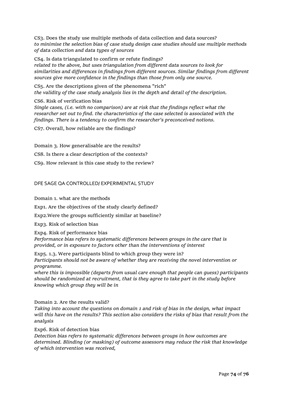
Page 74 of 76
CS3. Does the study use multiple methods of data collection and data sources?
to minimise the selection bias of case study design case studies should use multiple methods
of data collection and data types of sources
CS4. Is data triangulated to confirm or refute findings?
related to the above, but uses triangulation from different data sources to look for
similarities and differences in findings from different sources. Similar findings from different
sources give more confidence in the findings than those from only one source.
CS5. Are the descriptions given of the phenomena "rich"
the validity of the case study analysis lies in the depth and detail of the description.
CS6. Risk of verification bias
Single cases, (i.e. with no comparison) are at risk that the findings reflect what the
researcher set out to find. the characteristics of the case selected is associated with the
findings. There is a tendency to confirm the researcher's preconceived notions.
CS7. Overall, how reliable are the findings?
Domain 3. How generalisable are the results?
CS8. Is there a clear description of the contexts?
CS9. How relevant is this case study to the review?
DFE SAGE QA CONTROLLED/ EXPERIMENTAL STUDY
Domain 1. what are the methods
Exp1. Are the objectives of the study clearly defined?
Exp2.Were the groups sufficiently similar at baseline?
Exp3. Risk of selection bias
Exp4. Risk of performance bias
Performance bias refers to systematic differences between groups in the care that is
provided, or in exposure to factors other than the interventions of interest
Exp5. 1.3. Were participants blind to which group they were in?
Participants should not be aware of whether they are receiving the novel intervention or
programme.
where this is impossible (departs from usual care enough that people can guess) participants
should be randomized at recruitment, that is they agree to take part in the study before
knowing which group they will be in
Domain 2. Are the results valid?
Taking into account the questions on domain 1 and risk of bias in the design, what impact
will this have on the results? This section also considers the risks of bias that result from the
analysis
Exp6. Risk of detection bias
Detection bias refers to systematic differences between groups in how outcomes are
determined. Blinding (or masking) of outcome assessors may reduce the risk that knowledge
of which intervention was received,